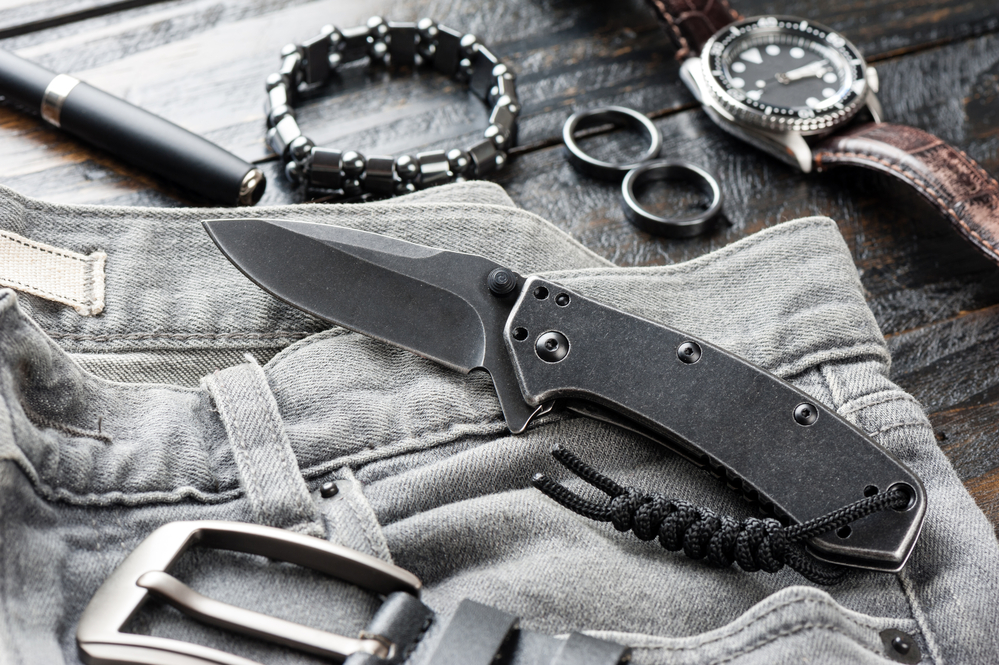The laws regarding carrying weapons in Alberta and throughout Canada are becoming increasingly stringent. The Firearms Act 1995 regulates gun licensing. Following the horrific mass murder in Nova Scotia in May of 2020, the government banned the ownership of more than 1,500 models of military-type assault rifles and other firearms. Certain types of ammunition are also now prohibited.
But what about knives? Every household has them. Chefs use them to slice meat and cut vegetables. Surgeons use scalpels. Landscapers depend on soil diggers and hori hori knives. Warehouse workers use them to open boxes. Florists need them to cut flower stems. Contractors, electricians, plumbers, painters, carpenters and other tradespeople use everyday carry (EDC) knives or knives specific to their occupation.
In addition to firearms regulations, airlines have restrictions on the types of knives and/or sharp objects that can be carried on board: this includes items that include razor blades such as box cutters, hatchets and cleavers, swords and sabres, scissors with blades longer than 6 cm from the fulcrum, and knives with blades longer than 6 cm. (For flights to the US, no knife of any type is allowed in carry-on baggage or on your person.)
Beyond what can and cannot be carried with you on a flight, there are certain knives that one cannot legally possess in Canada.
Table of Contents

What types of knives are illegal in Alberta?
According to Section 84(1) of the Criminal Code of Canada, knives that are considered to be prohibited weapons is one that “has a blade that opens automatically by gravity or centrifugal force or by hand pressure applied to a button, spring or other device in or attached to the handle of the knife.”
Knives of this type include:
- Automatic knives: These open automatically (revealing the blade) when hand pressure is applied to a spring, lever, or button that is in or otherwise attached to the knife. The knife may be side-opening or out-the-front. Italian stilettos and switchblades are common automatic knives, although not all are automatic knives.
- Centrifugal force knives: These can be opened simply by flicking the wrist. In other words, the centrifugal force initiated by the circular motion of the wrist action directed outwardly from the center of rotation causes the blade to open. Balisong knives (or Batangas, butterfly, fan, or folding knives) are centrifugal force knives.
- Gravity knives: Originally designed for paratroopers in World War II, allowing them to cut themselves free of their parachute’s shroud lines. As the name implies, it is a knife that opens up through the force of gravity, although it may also have a lever or button control.
- Pilium ballistic knives: These knives have a detachable blade that can be ejected to a distance of several meters by pressing a trigger or operating a lever or switch on the handle, making them exceptionally dangerous.
- Push daggers: These typically are short-bladed knives with a handle that is grasped with a closed fist. While they don’t fit the description of “having a blade that opens automatically by gravity, centrifugal force or hand pressure,” it is generally regarded as a combat-type weapons, which makes it an illegal knife.
- Belt buckle knives: A belt with a knife concealed in the buckle. These are also called “Constant Companion” knives.
- Knuckle knives: Also known as knuckle duster knives, they are considered a weapon. They fit on the knuckles (like “brass knuckles”) and may have either a folding blade or a fixed blade.
- Spiked wristbands: Where the spikes are not filed down or blunted, a spiked wristband is considered a weapon. This also applies to spiked finger rings.
- Any concealed blade under 30 cm: These generally look like an everyday object but conceal a small blade. They may be inside a pen, a lipstick tube, or even a necklace or a credit card case. No matter the method of concealment, they are designed to be weapons and are therefore illegal.
What kinds of knives can you legally possess in Alberta?
Given the number of occupational needs for knives, as well as the hunting and fishing tradition in Alberta, knives that are legal under Canada knife laws include those that are:
- Sheathed
- Have a fixed blade
- Take two hands to open
Other types of knives that may otherwise be prohibited may be legal in certain circumstances; for instance, emergency medical technicians may use a knife that can be opened with one hand. In that case, it is legal, provided it is used only for that occupational (medical or rescue) purpose.
Of course, even “legal” knives can become illegal if used in the commission of a crime. Pulling a hunting knife in a bar fight is against the law and will likely get you arrested. In fact, according to Statistics Canada, homicides caused by stabbings have increased by nearly 36% between the years 2018 and 2022.
What types of knife sales are against the law in Alberta?
Unlike the heavy restrictions regarding gun sales and licensure, there are no laws against the sale of knives…even those that are illegal to carry. There is no specific law that puts restrictions on the types of knives that can be purchased in a home improvement, hardware, sporting goods or similar retail establishment, nor is there a requirement for a background check on the purchaser.
The importation of illegal knives into Canada, whether from the United States or elsewhere, is prohibited under Canadian law.
Consequences of illegal knife-carrying
Possession of an illegal knife or possession of a knife with criminal intent may lead to severe penalties. As spelled out in the Canada Criminal Code, knife possession is against the law when and if:
- The person who carries or possesses a weapon or prohibited device uses it for “a purpose dangerous to the public peace or for the purpose of committing an offence.” If found guilty, the punishment for committing an offence is “imprisonment for a term not exceeding ten years; or “punishable on summary conviction.”
- A person who carries an illegal weapon (knife) into or on the way to a public meeting “without lawful excuse” is committing an illegal act. If convicted, the party is “punishable on summary conviction.”
- Someone carrying a concealed weapon, including a prohibited device, unless authorized to do so, has committed an offence. Punishment includes imprisonment for a term not exceeding five years or punishable on summary conviction.
Canada knife laws regarding search and seizure
A peace officer can search you and seize a knife where he or she believes there are “reasonable grounds” that a knife was used in committing an offence or is illegal, as defined by 84(1) of the Criminal Code. Search and seizure may not require a warrant if the peace officer “is satisfied that there are reasonable grounds to believe that it is not desirable, in the interests of the safety of the person or any other person,” for the person to possess the weapon; or because ” because of possible danger to the safety of that person or any other person, it would not be practicable to obtain a warrant, search for and seize any such thing… that is held by or in possession of the person.”
If you are approached by law enforcement in a search and seizure situation, it is in your best interest to comply with their requests and ask for permission to do anything while the search is underway. Quick movements and aggressive behaviour only escalate a tense situation, never more so than when a weapon is involved. Any questionable actions by the peace officers are best dealt with in court, with a violent offences lawyer on your side.
Using a knife in self-defence
Self-defence laws in Canada are not only complicated, but they are also full of grey areas. Who wouldn’t feel the need to defend themselves, their family members, and their property if, for instance, someone broke into their home in the middle of the night? Under Sections 34 and 35 of the Criminal Code, Canada knife laws regarding legal self-defence must meet certain thresholds:
- Was there reasonable fear of serious bodily harm or imminent death from an intruder or attacker?
- Was the defence applied for the purpose of defending and/or protecting oneself or another person from someone else using force or threat of force?
- Was the reaction, or the act of self-defence, reasonable? In other words, if you were being attacked or threatened by someone much smaller and weaker than you, was stabbing them with a knife a proportional and reasonable response? In that case, the answer is probably no. But this is where the grey areas are most evident. The court would look at a number of factors, such as:
- The nature of the threat
- Whether the threat of force was imminent and if so, were there other ways to deter the threat
- Whether the person (intruder or attacker) used or threatened to use a weapon
- Was there a prior relationship between the parties, including an earlier threat of violence or force?
- Did the parties involved have any prior communication?
- Was the other party provoked into making the threat?
When somebody feels endangered, it’s human nature to want to respond. It is hard to think about proportionality and “reasonable grounds” when faced with a potentially dangerous situation. It is up to the courts to decide whether someone claiming self-defence is criminally culpable or acted appropriately.
Contact the experienced Albertan knife offence lawyers
Because of the complicated nature of Canada’s knife laws, it is in your best interest to work with a Chadi & Company lawyer who has extensive knowledge in this area. Whether you have been arrested for possession of an “illegal” knife or are facing a serious charge regarding self-defence with a knife, it is imperative to work with lawyers who have a successful track record of defending clients in knife offence cases. Contact us online or at 780-429-2300 today.






